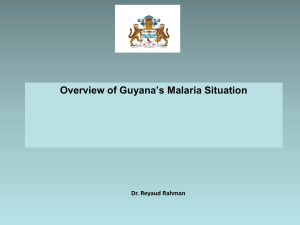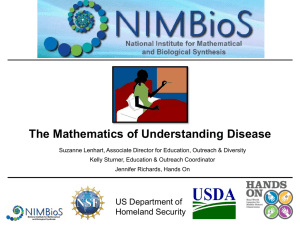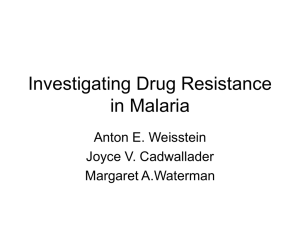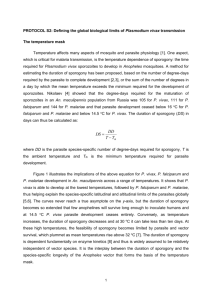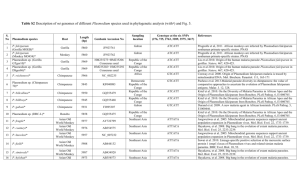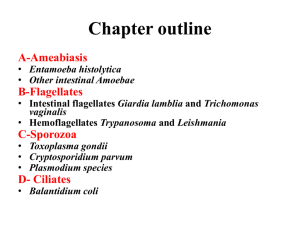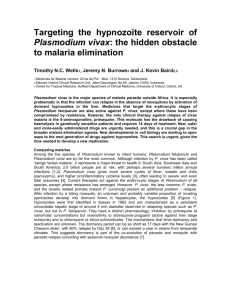Malaria in children upto the age of 12 years
advertisement
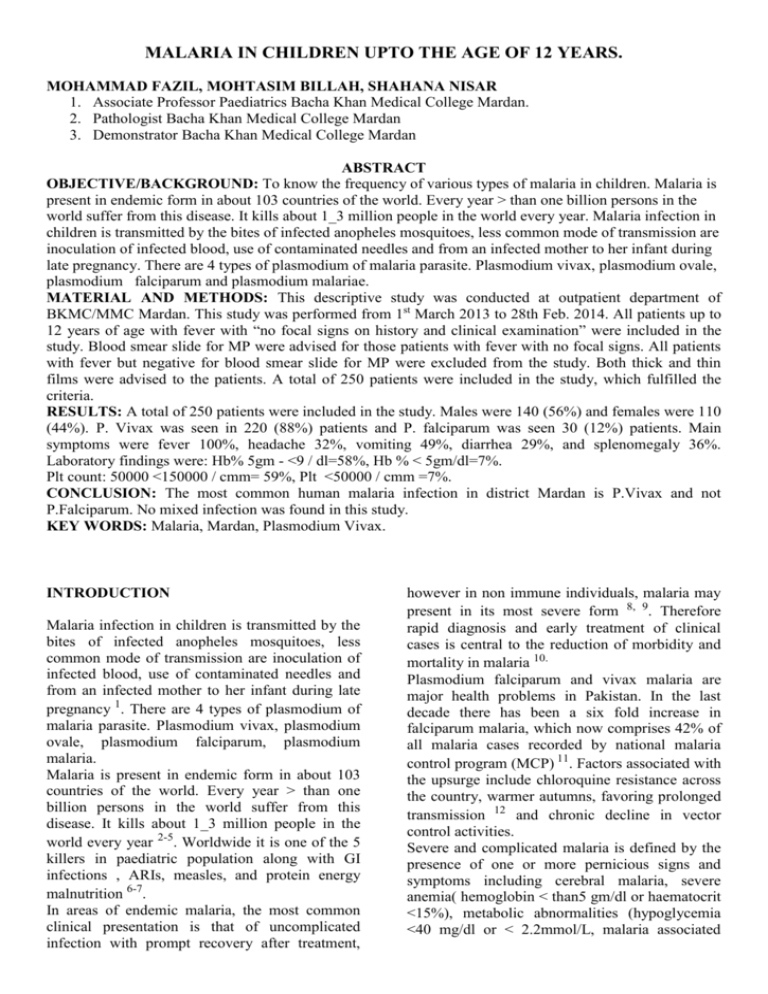
MALARIA IN CHILDREN UPTO THE AGE OF 12 YEARS. MOHAMMAD FAZIL, MOHTASIM BILLAH, SHAHANA NISAR 1. Associate Professor Paediatrics Bacha Khan Medical College Mardan. 2. Pathologist Bacha Khan Medical College Mardan 3. Demonstrator Bacha Khan Medical College Mardan ABSTRACT OBJECTIVE/BACKGROUND: To know the frequency of various types of malaria in children. Malaria is present in endemic form in about 103 countries of the world. Every year > than one billion persons in the world suffer from this disease. It kills about 1_3 million people in the world every year. Malaria infection in children is transmitted by the bites of infected anopheles mosquitoes, less common mode of transmission are inoculation of infected blood, use of contaminated needles and from an infected mother to her infant during late pregnancy. There are 4 types of plasmodium of malaria parasite. Plasmodium vivax, plasmodium ovale, plasmodium falciparum and plasmodium malariae. MATERIAL AND METHODS: This descriptive study was conducted at outpatient department of BKMC/MMC Mardan. This study was performed from 1st March 2013 to 28th Feb. 2014. All patients up to 12 years of age with fever with “no focal signs on history and clinical examination” were included in the study. Blood smear slide for MP were advised for those patients with fever with no focal signs. All patients with fever but negative for blood smear slide for MP were excluded from the study. Both thick and thin films were advised to the patients. A total of 250 patients were included in the study, which fulfilled the criteria. RESULTS: A total of 250 patients were included in the study. Males were 140 (56%) and females were 110 (44%). P. Vivax was seen in 220 (88%) patients and P. falciparum was seen 30 (12%) patients. Main symptoms were fever 100%, headache 32%, vomiting 49%, diarrhea 29%, and splenomegaly 36%. Laboratory findings were: Hb% 5gm - <9 / dl=58%, Hb % < 5gm/dl=7%. Plt count: 50000 <150000 / cmm= 59%, Plt <50000 / cmm =7%. CONCLUSION: The most common human malaria infection in district Mardan is P.Vivax and not P.Falciparum. No mixed infection was found in this study. KEY WORDS: Malaria, Mardan, Plasmodium Vivax. INTRODUCTION Malaria infection in children is transmitted by the bites of infected anopheles mosquitoes, less common mode of transmission are inoculation of infected blood, use of contaminated needles and from an infected mother to her infant during late pregnancy 1. There are 4 types of plasmodium of malaria parasite. Plasmodium vivax, plasmodium ovale, plasmodium falciparum, plasmodium malaria. Malaria is present in endemic form in about 103 countries of the world. Every year > than one billion persons in the world suffer from this disease. It kills about 1_3 million people in the world every year 2-5. Worldwide it is one of the 5 killers in paediatric population along with GI infections , ARIs, measles, and protein energy malnutrition 6-7. In areas of endemic malaria, the most common clinical presentation is that of uncomplicated infection with prompt recovery after treatment, however in non immune individuals, malaria may present in its most severe form 8, 9. Therefore rapid diagnosis and early treatment of clinical cases is central to the reduction of morbidity and mortality in malaria 10. Plasmodium falciparum and vivax malaria are major health problems in Pakistan. In the last decade there has been a six fold increase in falciparum malaria, which now comprises 42% of all malaria cases recorded by national malaria control program (MCP) 11. Factors associated with the upsurge include chloroquine resistance across the country, warmer autumns, favoring prolonged transmission 12 and chronic decline in vector control activities. Severe and complicated malaria is defined by the presence of one or more pernicious signs and symptoms including cerebral malaria, severe anemia( hemoglobin < than5 gm/dl or haematocrit <15%), metabolic abnormalities (hypoglycemia <40 mg/dl or < 2.2mmol/L, malaria associated with peripheral circulatory failure or shock, black water fever, renal failure, spontaneous bleeding ( thrombocytopenia, DIC ), pulmonary edema, and jaundice with peripheral blood smear positive for malaria parasite 13. In Pakistan resistance to chloroquine is on the rise and reported in up to 16_62% of p. falciparum cases 14. Chloroquine resistance p. falciparum malaria was first detected in Pakistan during the year 1981, in district Sheikhupura of Punjab, since then the problem of drug resistance is gradually increasing in various other regions of Pakistan 15. The recommended therapy to chloroquine resistance is parenteral quinine, but the case fatality rate is 10-30 percent despite treatment due to its decreasing efficacy in severe malaria 16, 17. This study was performed at OPD of paediatric MMC Mardan to know the type of malaria infections in our Hospital. Material and methods: This descriptive study was conducted at OPD of paediatrics with facilities of clinical laboratory in this Hospital. This study was performed from 1st March 2013 to 28th Feb 2013 for one complete year. Inclusion criteria: All patients up to 12 years of age with fever with no focal signs on history and clinical examination were included in the study. Blood smear Slide for MP was advised for those patients with fever but with no focal signs of other infections. Exclusion criteria: All patients with fever but negative for slide for MP were excluded from the study. Both thick and thin films were advised to the patients. A total of 250 patients were included in the study, which fulfilled the criteria. RESULTS A total of 250 patients were included in the study. Males were 140 (56%) and females were 110 (44%). P.vivax was seen in 220 (88%) patients and p.falciparum was seen 30 (12%) patients. Table no 1. Total no of patients. Sex No Males 140 Females 110 Total 250 % age 56 44 100 Table no 2. Total no of plasmodium parasites. Type plasmodium of No Percentage p. vivax p. falciparum p. ovale p. malariae Total 220 30 Nil Nil 230 88% 12% 0% 0% 100 Table no 3. Common symptoms and signs. Symptoms Percentage Fever 100% Headach 32% Vomiting 49% Diarrhea 29% Splenomegaly 36% Table no 4. Lab. profile. Lab. Profile Range Hb. <9-5gm/dl Hb. <5gm/dl Platelet <15000050000/cmm Platelet <50000/cmm Percentage 58% 7% 59% 7% Main symptoms were fever 100%, headache 32%, vomiting 49%, diarrhea 29%, and splenomegaly 36% (table no 3). Laboratory findings were: Hb. 5gm- <9gm / dl= 58%. Hb% < 5gm / dl=7%. Plt. Count: 50000- <150000/ cmm=59%. Plt. <50000/ cmm=7 %.( table no 4). DISCUSSION This descriptive study was conducted at OPD of paediatrics MMC Mardan to know the type of malaria in children. In our study males were 140 (56%) and females were 110(44%). P.vivax was positive in 220 (88%) and p.Falciparum in 30 (12%). Idrees et al noted 72% p.vivax and 24.1% p.Falciparum at Ayub teaching hospital Abbottabad 18. In study done by Jalal et al, P.Vivax was 92.21% and P.Falciparum was 7.21% 19. Yasinzai and kakarsulemankhel 20 observed high prevalence rate of p.vivax 88.6% than p.falciparum 11.3%.These studies are more or less the same as our study. Jamal MM noted p.vivax in 62.5% p.falciparum in 36% and mixed infection in 1.5% 21 In one study from Iranian parts of south east Caspian Sea, high rate of p. vivax was observed than p.falciparum 22. In our study thrombocytopenia was present in 66 %, anaemia in 65 %, and splenomegaly in 36% while other studies shows 72 % thrombocytopenia 23 , 20 % anaemia and 20% splenomegaly 24. In southern Punjab, P. vivax was found to be more prevalent (39.0%) than P. falciparum (36.6%). 24 in Karachi, P. falciparum was observed to be dominating (90.99%) compared to P. vivax (9.0%). 25 CONCLUSION The most common malaria in this study is P. Vivax and not P.Falciparum. Although P. Falciparum malaria is also present in this part of Khyber Pakhtunkhwa but in lesser percentage than P. Vivax malaria. No mixed infection was found in this study. CORRESPONDING ADDRESS: Dr. Mohammad Fazil Associate Professor of Paediatrics Bacha Khan Medical College, Mardan Khyber Pakhtunkhwa Pakistan. Email:fazilbkmc@yahoo.com. cell no:03339213261.
